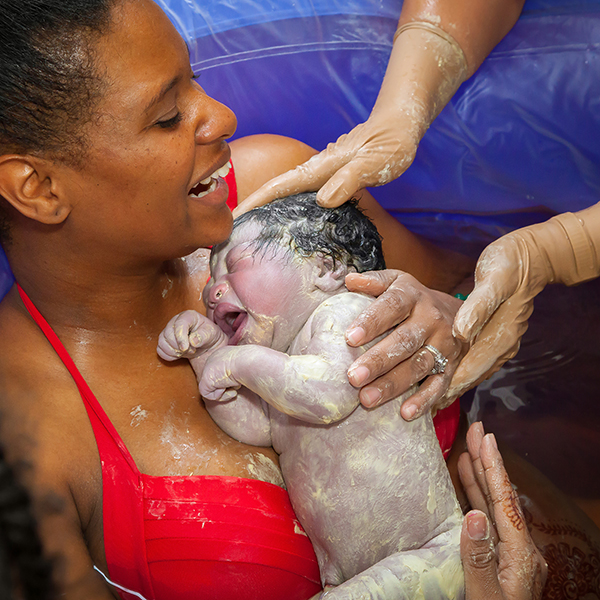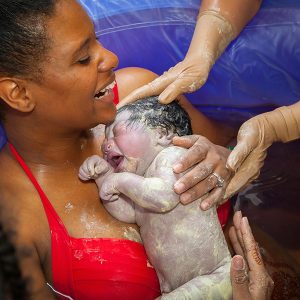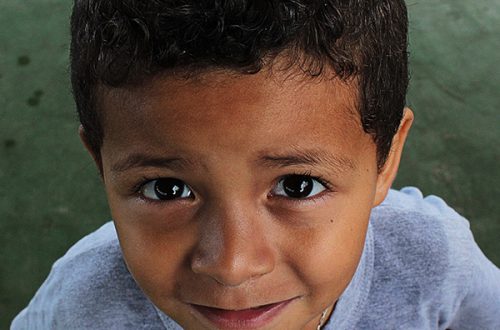
The Golden Hour
By Laura Maxson


The first hour after birth is known as the golden hour for good reason. A newborn is at a heightened level of alertness during this time, more alert than it will be again for a few weeks. Babies are born with an internal checklist for survival that attentive parents can observe while marveling over just how smart their little one is. There is no hurry to get the baby to breast and the reality is that the first attachment often goes a little smoother when the baby leads the way. Immediately after birth the baby goes skin-to-skin now on the outside of the baby bump. Tummy-to-tummy, both baby and mother can catch their breath, as there is no agenda but to observe and fall in love.
The baby’s body should be gently dried (except the hands) then loosely covered with a dry blanket. It is important not to bathe the baby at this point as the amniotic fluid smell that lingers on the baby’s hands is similar to the smell of the nipple and actually helps the baby to find the breast.
Some babies will get right to work squirming their way up toward the breasts, while others will rest for a bit before beginning their breast crawl. Babies can range from quiet-alert to quite vocal. Soft voices and dim lights can help them settle and encourage them to open their eyes and look around. Give them time to get themselves organized. They are safe and warm – tummy-to-tummy and skin-to-skin – until they are ready to get moving.
It might look like babies are not doing anything, but they are going through that checklist. The baby will begin to salivate in anticipation of their first meal, often making little bubbles in their mouth. Their mouth will begin to get active, poking their tongue in and out, smacking their lips and licking/sucking on their own hands and fingers.
A baby lying skin-to-skin does not need any procedures, including receiving an injection or placing medication in the eyes. There’s no need to weigh or measure the baby at this point and unless the baby needs help to breathe, they should be left alone.
The newborn will instinctively begin to make crawling motions with their feet and knees helping to move up the abdomen toward the breasts. It’s a big journey for a new baby and it will likely have several starts and stops. Baby is busy, even when the newborn isn’t actively crawling and squirming their way up to the breast; they may take a rest, but it’s a working rest.
Baby will be alternately reaching their hand out and bringing it back to their mouth and tongue as they move to the breast. Eventually they will begin to bob their head about, swiping back and forth, mouthing the skin – looking, feeling, tasting, and smelling to locate the nipple.
Baby will often stare hard at the nipple when it is within reach. There is a little dance of hand to mouth, hand to nipple, then sucking on the hand that is still holding on to the nipple and so on. Eventually, the baby gets lined up, lifts its head, opens wide and lunges for the nipple. Success!
Or maybe not, maybe that was just another in several attempts as the baby works on feeding skills. Babies will often find themselves suddenly staring into their parents’ faces. Both will be mesmerized and drinking each other in with their eyes. This is important work as well, and a big part of their important survival skills.
Those unaware of the value of the golden hour after birth might easily miss this opportunity by taking the lead on attaching the baby or using this time to pass the baby around to other family members to ooh and ahh over. Experience and studies show that giving a baby and parents this time together, undisturbed, for the baby to find its way to the breast helps build breastfeeding success.
Of course, parents can only do what they know or circumstances allow. Latching adjustments may still need to be worked on as breastfeeding gets established. Emergency situations or other complications can take precedence to a leisurely golden hour. Babies born by cesarean section can also participate in skin-to-skin with a little help and higher up on the chest. Another person can provide skin-to-skin while waiting for the birthing parent to become available and/or help facilitate the skin-to-skin and breast crawl on a parent not able to fully participate on their own due to anesthesia or exhaustion. The golden hour can also be recreated days or weeks after birth providing an opportunity for healing from a rocky start.
Breastfeeding support resources – Birthnet.org
Breast Crawl video – globalhealthmedia.org choose “Breastfeeding in the First Hours”


You May Also Like

Crazy Decisions
November 2, 2020
Connected Holidays
November 2, 2020

